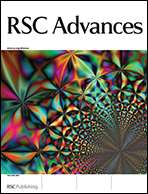Rapid hybridization using graphene oxide and 1,1′-oxalyldiimidazole chemiluminescence†
Abstract
A rapid hybridization method using graphene oxide and highly sensitive 1,1′-oxalyldiimidazole chemiluminescence (ODI-CL) detection was developed from an understanding of the chemical and physical interactions between single strand DNA (ssDNA) molecules and nanoparticles (e.g., multi-walled carbon nanotubes, graphene oxide, gold and silver nanoparticles). The efficiency of hybridization between mutated ssDNA and a complementary probe conjugated with TEX615 was dependent on four different variables: pH, temperature, incubation time, and properties of nanoparticles capable of capturing excess complementary probes remaining after the hybridization. A critical problem observed when mutated ssDNAs rapidly bound with complementary probe-conjugated TEX615 was that three different types of possible mismatched ssDNAs also slowly and competitively hybridized with complementary probe-conjugated TEX615. The problem was solved upon addition of three different types of complementary probes, not conjugated with TEX615, in the solution because mismatched DNAs hybridize with their complementary probes while mutated ssDNAs bind with complementary probe-conjugated TEX615. The new hybridization method using graphene oxide and ODI-CL detection quantified trace levels of mutated ssDNAs in a sample containing mismatched ssDNAs within 15 minutes without any interference from mismatched ssDNAs.


 Please wait while we load your content...
Please wait while we load your content...